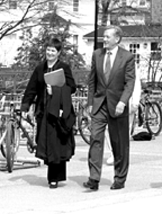


The loudest contributors to Bruce Babbitt's panel discussion on race stood outside the Goodrich Room.
Secretary of the Interior Babbitt joined Oberlin students, professors and administrators Tuesday for an intimate discussion sponsored by President Clinton's Initiative on Race. Although the dialogue often veered dangerously close to silence, most participants pronounced the event a success.
After the panel concluded, Associate Professor of African American Studies Adrienne Lash-Jones shook Babbitt's hand. "Thank you," she said. "I'm sorry half of the students were suddenly dumbfounded. It's so unlike Oberlin students."
The 40-minute discussion still managed to touch briefly on program houses, crime and affirmative action.
"The conversation went better than I thought it might," College President Nancy Dye said. "It was so formal."
Despite protesters' efforts to disrupt the panel with loud calls for affirmative action, the discussion continued as planned.
The forum was carefully arranged by the White House. Vice-President of College Relations Al Moran said, "Could we have done something differently? Sure, but it wasn't our show."
Some participants complained that the format was unclear, leading to awkward silences. Although students made an effort to contribute to the discussion, Babbitt posed less questions than panelists expected.
The White House dictated the composition of the panel and the audience.
Dye, Assistant Professor of Religion A.G. Miller, sophomore Selena Kirk and seniors Andrew LaVallee themselves to watching the debate on local cable.
Babbitt opened the discussion by recalling his time spent in the Civil Rights Movement.
"I was awakened to these issues in Spring 1965," Babbitt said. "I picked up and left school and went to Selma. When I tell my sons about those years in the South, they say 'Dad, that was a very simple time.' Today we live in a complex time."
Babbitt said he jumped at the chance to travel to Oberlin for the President's Initiative's Campus Week of Dialogue.

"There wasn't any hesitation on my part," Babbitt said. "I wanted to come here to listen to you."
Babbitt's tale was met with silence.
"Secretary Babbitt, do you have any specific questions?" Dye asked.
Babbitt had a few. "What is your perception of problems in this community?" he asked. "Is it just a few rednecks from my part of the country who've shown up at Oberlin? What is your perception of barriers here in school? Do you all get along? Is it the Utopia I keep reading about?"
Waller assured him it was not.
"Oberlin is very progressive," Waller said, "but I believe it rests on its history."
LaVallee said, "I came to Oberlin from public school in Mobile. My personal experience is racism is more virulent in the South. I think the way racism comes up here is more PC."
Miller said he believes there is a real fear of Balkanization at Oberlin that sometimes leads people to question the wisdom of creating program houses.
Waller said, "People need a home when they go home at night. I've lived in Afrikan Heritage House for four years. If I stayed here two more years, I'd live there two more."
"The notion of home is important," Dye said. "There is so much cultural anxiety, particularly on the part of white Americans, to get to know each other. People will ask, 'How come you see a table of all black students?' I've never heard this issue come up but for a table with all whites around it."
Kirk Russell, an African American studies teacher at Oberlin High School, was the last member of the audience to speak.
"We have white students who choose not to take this class," Russell said, motioning to his students, who were nearly all black. "Black students live the black experience; white students do not. Once we understand that courses with names are relevant than we can start building bridges. What are we going to do when we leave here? This panel's not going to be here tomorrow, so what are we going to do?"
Keith James, one of Russell's students, said he wished there had been more discussion of what high schoolers could do. Although James did not get a chance to speak during the forum, he said, "I think the panel was great."
After the panel, Babbitt said, "What did I learn from this? What do I bring back? I learned from the Balkanization discussion the importance of trying to find the right balance. I learned this is very complex. We're going to be doing more of this."
Power walking: College President Nancy Dye leads Secretary of the Interior Bruce Babbitt across campus. (photo by Zach Fried)
Initiating discussion: Babbitt and Dye were two of the participants in Tuesday's panel on race relations in Oberlin.(photo by James Cochran)
Copyright © 1998, The Oberlin Review.
Volume 126, Number 20, April 10, 1998
Contact us with your comments and suggestions.